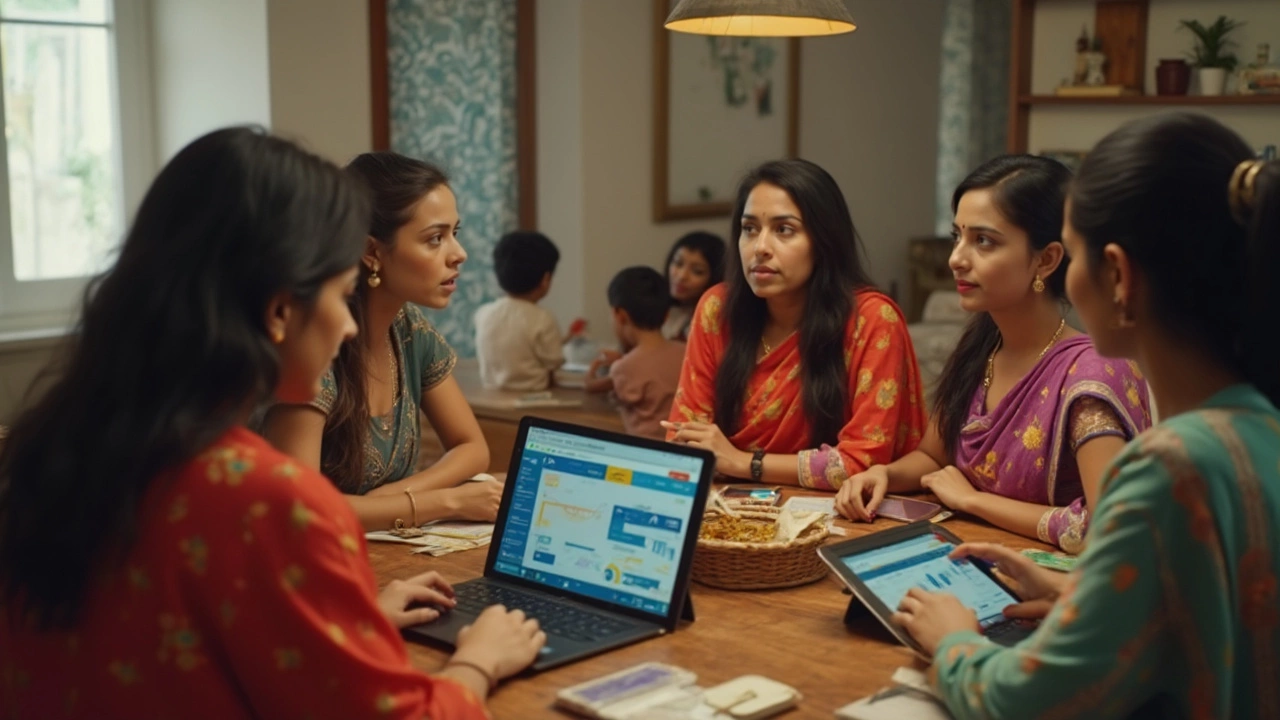Can a Housewife Do Trading in India? Everything You Need to Know

Trading isn’t just a guy’s game sitting on Wall Street anymore. Hundreds of Indian housewives are quietly building side incomes—or even replacing their family’s main earnings—without ever leaving the kitchen table. No stuffy offices, no bosses, no commutes. The only requirement? A smartphone, a reliable internet connection, and a pinch of curiosity.
What’s making this possible? Online stock trading platforms are easier than ever. You can learn the basics of stocks, commodities, or even crypto through short online trade courses. These courses usually speak your language (literally—think English, Hindi, even Tamil), and most of them don’t expect you to be a math whiz or an MBA grad.
If you’re worried about starting capital, relax—many brokerages now let you begin with as little as Rs 500. And you don’t need to spend all day doing this. Many women spend under an hour a day and manage to build a useful side income. It’s absolutely possible. So let’s look at what women need to actually get started, what bumps may appear, and how to avoid the common mistakes. Ready? Let’s cut through the noise and talk real options for housewives who want to try their hand at trading in India.
- Why Trading Appeals to Housewives
- Tools and Courses You’ll Actually Need
- Step-by-Step: How to Start from Home
- Challenges Indian Women Face in Trading
- Inspiring Success Stories
- Smart Tips to Stay Safe and Profitable
Why Trading Appeals to Housewives
Housewives in India juggle loads of responsibilities—managing the home, kids, family budgets. Long office hours or a nine-to-five just aren’t practical for many. But trading? That slips right into their routine. Let’s be real: Trading can be done in short bursts, fits flexibly around chores, and doesn’t require fancy degrees or connections.
Many Indian women want to support their family’s income without stepping out or sacrificing time with their kids. The rise of work-from-home everything opened new doors, and trading took off—especially after the 2020 lockdown when more women started exploring digital money-making ideas. Stock broker Zerodha reported in late 2023 that over 15% of their new accounts were opened by women, and a big chunk of those were homemakers.
| Year | % of Zerodha New Accounts by Women |
|---|---|
| 2018 | 5% |
| 2021 | 11% |
| 2023 | 15% |
Trading also lets housewives use skills they already have. If you’re careful with household budgets, you already get the basics of risk and money management. Some even enjoy treating it like a daily puzzle or challenge, hunting for profits while the rest of the house is asleep or at school.
“The biggest draw for women is flexibility—trading lets you work around your schedule and be financially independent without leaving home,” says Suneetha Reddy, Director at IIM Skills, a well-known upskilling platform.
And here’s something that gets overlooked: Family members often come around fast when the earnings start rolling in. That's a confidence boost. For many, that first successful trade lights a fire, showing it’s possible for a housewife trading India to become a regular thing. The technology is simple, costs are low, and the pride in contributing money—big or small—is huge. It’s no wonder more housewives are jumping in than ever before.
Tools and Courses You’ll Actually Need
You don’t need a fancy setup to dive into housewife trading India. A basic smartphone or a laptop, plus a stable internet connection, covers your must-haves. Many trusted broking apps, like Zerodha, Upstox, and Angel One, work just fine on regular phones and don’t chew up much data. If you can manage basic net banking and WhatsApp, the tech doesn’t get more complicated than that.
Getting started also means choosing a broker, which is basically the platform where you buy and sell stocks. Zerodha and Upstox are top picks in 2025 because they have easy sign-up steps, low paperwork, and reliable support in local languages. Make sure your chosen broker is SEBI-registered—that’s non-negotiable for safety. Opening a Demat and trading account is usually paperless these days. You upload an Aadhaar and PAN, do a quick video call, and you’re in.
Now, about learning trading: don’t fall for any random YouTube “guru.” Look out for genuine online trade courses designed for beginners. NSE Academy and BSE Institute both run affordable, legit basics-of-stock-market courses. Some cost as little as Rs 500–1000 and run for a week or two. They have WhatsApp groups and Q&A support, so you won’t be lost. Apart from these, websites like Elearnmarkets and Varsity by Zerodha, offer free bite-sized lessons with simple quizzes. You don’t need perfect English—Hindi, Marathi, Tamil, and Bengali options are common.
- Step 1: Get your own device and a steady internet line.
- Step 2: Pick a SEBI-recognized broker with good app reviews and support in your language.
- Step 3: Take an online course meant for total beginners—avoid anything promising big profits with zero risk.
- Step 4: Join demo trading platforms or start with "virtual money" to practice before putting in real funds.
Don’t forget to download a reliable business news app—Moneycontrol, Economic Times Markets, or your brokerage’s own news feed—to track what’s happening daily. These tools and courses are your launch pad. And honestly, you don’t need anything more to start smart.
Step-by-Step: How to Start from Home
If you're thinking, “How do I jump in?”—here’s the simplest way to kick off your journey into trading from home in India. No need to rush; just follow these clear steps, one by one. Don’t skip any, especially if you’re new to the game.
- Set Up Your Basics: You’ll need a bank account and a PAN card. Both are absolutely necessary for opening a trading or Demat account in India. If you don’t have these yet, get them sorted first. No stock broker will let you open an account without them.
- Pick a Reliable Broker: Go for well-known platforms like Zerodha, Upstox, Angel One, or ICICI Direct. These brokers are safe, easy to use, and let you start with small amounts. Most support everything online—including the paperwork—so no need to visit an office.
- Complete KYC Online: After picking a broker, upload your documents for KYC (Know Your Customer). This usually includes an Aadhaar card, PAN card, a passport-sized photo, and a canceled cheque. Most brokers approve you in 24 to 48 hours.
- Download the Trading App: Almost every broker has a free app. Download it from Google Play or the App Store onto your phone or tablet. Login, follow the walkthrough, and get to know the basic buttons—buy, sell, portfolio, etc.
- Start with a Small Investment: Don’t put in huge money right away. Begin with something you’re totally okay with losing—think Rs 500 to Rs 2000 at first. Practice with this until you’re comfortable.
- Follow Free Training and Demo Sessions: Most reliable platforms offer basic tutorials and demo accounts. Many Indian trade courses online also give step-by-step video walkthroughs in your preferred language. Don’t skip these! The more you watch, the less likely you are to make rookie mistakes.
Here’s a quick table so you can see how much you need to get started with some famous brokers:
| Broker Name | Minimum Account Opening Fees | Minimum Investment Amount |
|---|---|---|
| Zerodha | Rs 200 | No minimum |
| Upstox | Free | Rs 500 |
| Angel One | Free | No minimum |
| ICICI Direct | Rs 0-975 (depends on plan) | No minimum |
Last tip—always start by focusing on housewife trading India stories or discussion groups online. These communities answer questions quickly and share what works and what doesn’t. You won’t be alone; there are thousands trading from home every day. Just remember: go slow, learn every step, and never risk more than you can afford to lose.

Challenges Indian Women Face in Trading
Let’s be honest—jumping into trading as a housewife in India isn’t always a walk in the park. You’ll find hurdles that men usually don’t have to deal with, and most people don’t talk about them out loud. Knowing what you’re up against will help you stay prepared, so you don’t get discouraged early on.
The first roadblock is lack of family support. In many Indian households, the idea of a woman handling money and making investment decisions still meets with raised eyebrows. Many women report that their partners or elders aren’t fully convinced about spending family money on trading. This isn’t just talk: according to a 2024 report by the National Stock Exchange, only 17% of active retail traders in India are women, and most started with zero encouragement from home.
There’s also the challenge of time. Juggling kids, housework, and trading isn’t as smooth as online ads make it look. Finding a quiet half-hour can feel tough, especially if your household sees your trading as a "hobby" rather than work. Learning how to block time for research and trading is key.
Technology can be a headache, too. Not every housewife grew up with smartphones or feels comfy using trading apps. Many courses don’t cover the basics of online security—and scammers often target those new to digital finance, especially women.
Not to mention, access to trustworthy learning is still a problem. While there are some good housewife trading India courses, a lot of online content is either too basic, too advanced, or outright scams promising easy riches. No surprise—more than 35% of new traders in 2023 reported losing money due to poor-quality advice or fake tips.
Cost also matters. Even low-fee platforms have hidden charges, and most free webinars try to upsell expensive “premium” courses. For someone starting small, these extra expenses can add up.
Here’s how it stacks up for women traders in India right now:
| Challenge | Percentage of Affected Women* |
|---|---|
| Lack of family support | 55% |
| Tech comfort issues | 39% |
| Time management | 44% |
| Falling for scams/bad advice | 35% |
| Hidden costs | 28% |
*Source: 2024 survey by an Indian trading platform (sample: 1000 women traders)
The good news? Most of these challenges aren’t permanent. Tons of women are finding ways around them—through online communities, buddy systems, and keeping each other updated on scams. We’ll touch on solutions a bit later, but knowing the roadblocks is the first step to getting past them.
Inspiring Success Stories
It helps to see real women changing their lives with trading. It’s not about overnight riches; it’s about finding something that actually works for daily life. Let’s look at a few Indian housewives who carved their own space—and what we can learn from their experience.
housewife trading India is not a headline for a fairy tale. In 2019, Seema Jain from Indore became known across trading circles for turning a small home setup into a profitable trading desk. She started with just Rs 5,000, learned basics from free YouTube videos, then took a six-month NISM-certified online course. Within two years, she was earning close to Rs 30,000 a month by trading in equities and options. She told CNBC Awaaz in an interview,
"Trading worked because I could study, practice, and trade when my family was at school or work. It gave me a sense of freedom, not just money."
Raja Kumari from Chennai was struggling with household expenses. She began with commodity trading using a mobile app suggested by her cousin. By sticking to strict money management and only trading gold futures, she started making steady profits. Today, she runs monthly classes for other women in her apartment complex. These stories aren’t random—there’s a pattern: start small, get basic education, and don’t bet the whole house on a single trade.
Many housewives now join community forums like Women On Wealth, or WhatsApp groups focused on trade courses india, to swap tips and avoid scams. Data from the National Stock Exchange (NSE) shows the share of women trading account holders jumped from 16% in 2020 to over 22% in 2024. The table below sums up the changes in women’s presence in the Indian trading world:
| Year | Women Account Holders (%) | Major Learning Platforms |
|---|---|---|
| 2020 | 16 | YouTube, Zerodha Varsity |
| 2022 | 19 | Upstox Learn, Angel Broking Academy |
| 2024 | 22 | NISM, Women On Wealth |
The key here? Look at what these women did: learned the basics, started slow, and stayed consistent. Their journeys prove that anyone serious about learning and practicing can get real results—even while running a home.
Smart Tips to Stay Safe and Profitable
You shouldn’t trust anyone who tells you trading is quick, easy money. Most people lose when they treat it like gambling or if they’re too eager. If you want a shot at being one of the successful housewife trading India stories, you’ve got to know the real risks and follow some practical rules.
Here are some straightforward pointers that’ve worked for plenty of beginners:
- Start Small: No need to pump in big money at first. Test out the waters with tiny trades. If you mess up, you lose a little, but you gain experience—and that’s way more valuable early on.
- Pick the Right Broker: Go for well-known brokers registered with SEBI (the Securities and Exchange Board of India). Ignore flashy WhatsApp or Telegram groups promising “guaranteed profits.” SEBI’s own 2023 investor alert warned against unregulated tipsters—over 40 scams were reported last year alone.
- Always Use a Stop Loss: This is like your seatbelt in trading. It tells the platform “sell my stocks if prices fall below this limit,” so you don’t lose more than you can handle. Make this a habit from day one.
- Stay Curious, Keep Learning: Markets change. Try free demo accounts or use apps that simulate trading before you risk real cash. Check YouTube or free webinars from brands like Zerodha Varsity and NSE Academy.
- Watch Out for Emotional Trades: Don’t buy or sell on a whim or because of gossip. Have a plan and stick to it—note the reasons for each trade in a diary.
Here’s what Ms. Shweta Jain, a well-known financial educator, said to Business Standard in March 2024:
“Women new to the market must focus on learning before earning. Don’t let FOMO or overconfidence drive your decisions. Small, consistent efforts are what build real, lasting profits.”
Let’s look at some stats that put things in perspective. Check this data from SEBI and Indian brokers from 2024:
| Tip | How Many New Traders Use It? | Success Rate (%) After 1 Year* |
|---|---|---|
| Started with demo accounts | 58% | 43% |
| Set stop losses every trade | 71% | 47% |
| Followed social media tips only | 32% | 11% |
*"Success" means keeping their capital safe or making a steady profit after 12 months.
Remember—take profits when you have them, don’t chase losses, and keep learning. The real winners in trading? They play safe and last longer than everyone else.

Post-Comment